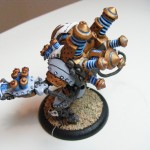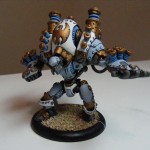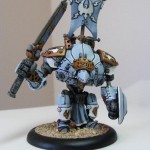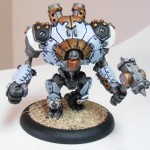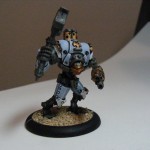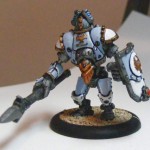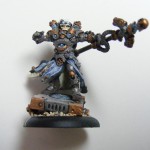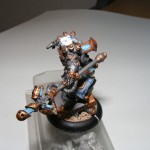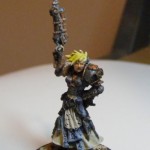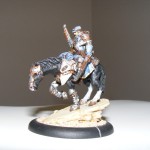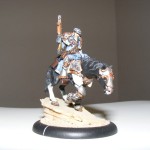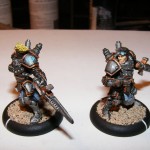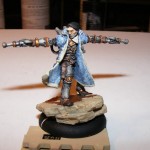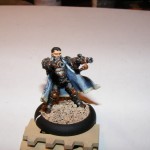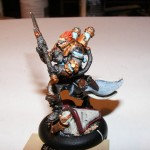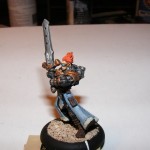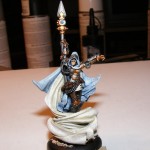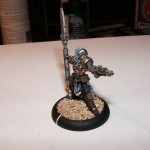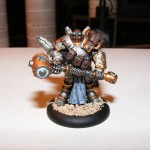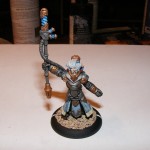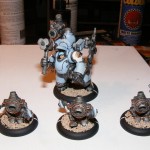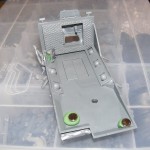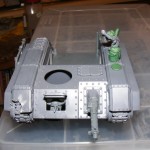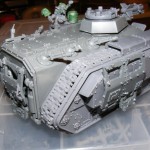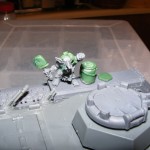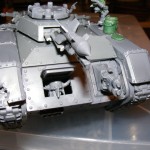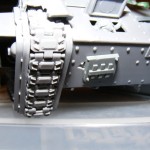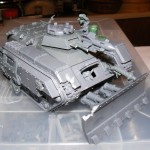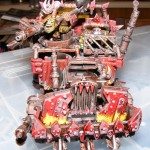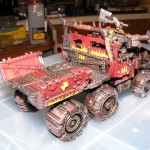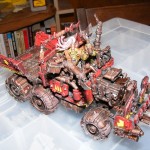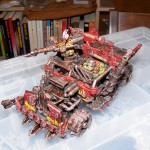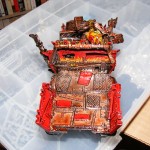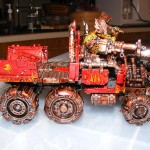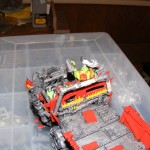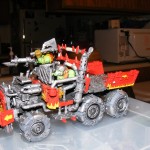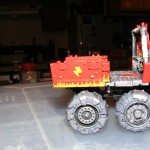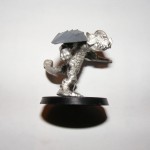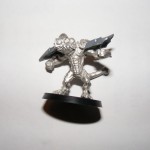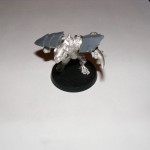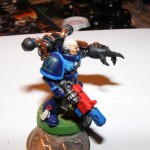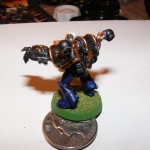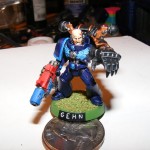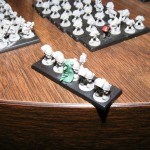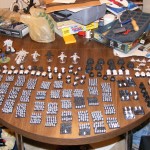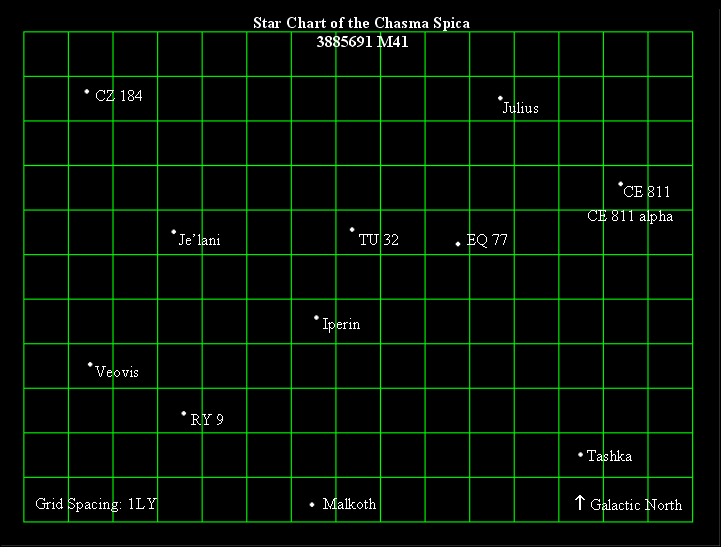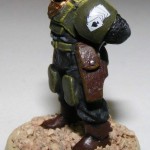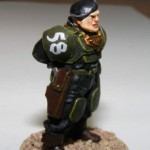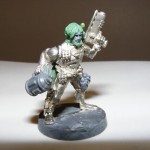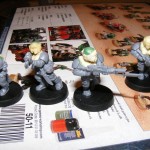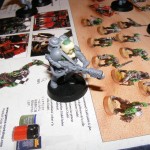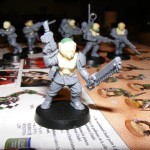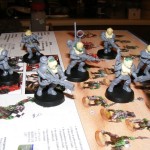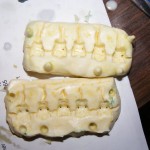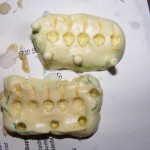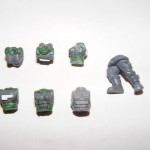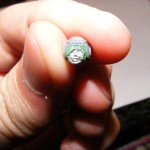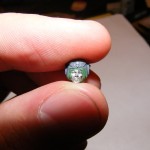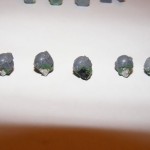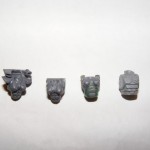Choosing a Color Scheme
Warmachine (and its sister game Hordes) is awesome, especially now that 2nd ed has toned down the insane stuff from Legends. That being said, the Iron Kingdoms is a much “smaller” world than 40K or even Warhammer Fantasy. In Warmachine all Cygnar armies ideally work for the nation of… anyone? Take a guess. That’s right: CYGNAR. One nation. One armed force. One color scheme. Boring. Sure, there are some alternate schemes in the Cygnar book, but even if everyone chose from those handful it would still be monotonous.
It is my contention that each player should create a completely original color scheme for each Warmachine faction they play. Red Cygnar? Awesome. Rusty Menoth with Black armor? Double-sweet.
When I choose to make a color scheme (for anything, not just Warmachine) I try to keep some sort of theme in mind. For the Azure Flames, it was a blue Marine army with crisp, clean perfection. There’s not a dirty model in the army. For the Orks it was wacky, dirty fun. When I chose to start painting Cygnar, it was around Apotheosis. If no one remembers the fluff that far back, Cygnar was beset on all sides by invading forces. It looked pretty grim for the boys (and girls) in blue. So, I figured they couldn’t afford as much blue in their paint and switched to a cheaper blue-gray. I also thought they’d run out of gold and switched to bronze. It’s a poor-man’s Cygnar for a desperate nation melting its own silverware to pay for the wars on like twenty seven fronts. Here is an image dump of all of my painted Cygnar stuff.
Telling a story with your model.
You can use modeling to tell a story without saying a word. I made a looted Ork vehicle. Look at all the pictures, try to see what the story behind the vehicle is, and then scroll down past the white space.
.
.
.
.
.
.
.
.
.
.
.
.
.
.
.
.
The Story
As you can see, there is damage to the front track guard and right side front hull. The Chimera was hit by severe antitank fire, coming from its right side. This immobilized it and allowed the Orks to capture and loot it. The rear door was ripped off and replaced. The damaged laser turret was upgraded to a Rokkit Launcha. That’s how this vehicle joined Poindexta Smartyskull’s warband. I tried to explain this with the way I built it. Some people loot Ork vehicles by just slapping gubbins on wherever. That’s fine, but I like my idea better.
Finally, as an extra modelling goody, I modeled Red Paint Job as something other than a red paint job. Of course there will be some red at the end, but it will get there because of Vincent Van Grot, on the top left side. He even has a bandage on his ear!
Dipping when you can’t “dip” – Ork Trukk
So Dipping is called that because you’re supposed to “dip” the mini in the woodstain. However, this is just the easiest way to get the stain on the mini. You can brush it on in cases where the mini is too large. This is the first Trukk I painted.
You can see the pre-stain, post-stain, and finished product. The yellows had to be reinforced, as the stain darkens them too much. I also added some splattered bugs!
Konquata Monitor Kroxigor
Three posts in one day? You have to admit, the Epic army post was pretty weak. So, here’s a Kroxigor.
The only thing I have left to do is rip apart one of my Skinks and make one more star player.
Gehn the Traitor, disciple of Matthius.
Modeling and Painting
Before Big Game 5, Matt Turner came down to help us build terrain. While he was there, we discussed his Chaos Lord, Matthius, Prophet of the Four. Matt said that he wanted Matthius to have a bodyguard of traitors from various armies. I wasn’t sure about other people’s armies, but I instantly came up with an addendum to the main fluff story that involved this man:
I used the new Devastator Sergeant head, with the flat top filed away. I used the Mark 9 sergeant armor torso, the old pewter bolter-melta, and a Chaos power fist, shoulder pad, and backpack. The body was damaged as if it had suffered an explosion on Gehn’s left side, which is the arm that was replaced. He was painted with the Azure Flames scheme, with a scheme similar to some of Matt’s chaos squads on the replaced arm. Gehn was given as a gift to Matt before Big Game 5.
Background
The name of Gehn is cursed by the Azure Flames more than any other. While the twists of Chaos have poisoned, mutated, or brainwashed battle brothers before, these individuals were exterminated. Unlike others, Gehn chose to betray the Chapter. The path between his recruitment and that fateful choice is twisted and convoluted. This account merely scratches the surface of the events that led Gehn to choose madness over loyalty.
Gehn’s recruitment into the Chapter, like most battle brothers, came when his world was in need. Riven was raided by Dark Eldar pirates for slaves year after year. Losses were deemed minimal by Imperial tacticians, due to the fact that Riven had always made its imperial tithe. Calls for aid went unanswered or were spectacularly late. In c783m41, the Dark Eldar met their match. The Battle Barge His Anvil leading approximately half the Azure Flames fleet met these raiders head on. In a pincer action, the Dark Eldar ships were corralled by escorts as capital ships closed in. Sadly, the captives aboard the ships perished in the attack, but the Dark Eldar raiding force was dealt a severe blow. As is customary, the Azure Flames requested that all boys of age be allowed to prove themselves worthy of joining the Chapter. Gehn was tested and proven well above his peers in the rigorous mental and physical challenges that all aspirants to the Azure Flames are put through, and the promising youth was quickly inducted into the Chapter.
Gehn’s career as a scout was not without glory, but was lackluster compared to some of his contemporaries. He was eventually chosen and passed the final trial to become a Space Marine, and served in the reserves for 60 years before joining the 4th Company. It is at this point that Gehn’s career became more illustrious. He participated in the raid on Arkh, and played a vital role in capturing the hidden ruling council. After several decades of service, he was eventually promoted to sergeant. During his tenure he killed a Carnifex in close combat and was at the forefront of the push to take the Traitor’s Gate on Yttran. Gehn’s ambition made him to continue to strive to become a captain, but though his service was admirable, no position of Captain was ever available.
Then Antonius was recruited into the Scouts. Gehn took notice when Antonius was advanced to Space Marine faster than any other Scout on record. He then became enraged when the youth was promoted to Sergeant of the 5th Squad, 4th Company after the infiltration action on Iperin during the Chasma Spica conflict. During Antonius’ induction ritual, Gehn refrained from joining in the toast. Antonius thought nothing of it, but Captain Ganendra did. He notified Atrus, and Atrus consulted his visions of the future. To his horror, the visions spoke that Gehn would betray the Chapter. Atrus sought to send the 4th Company into battle on Julius, and had Ganendra use the 6th squad as bait for the enemy. Gehn and his squad were hit by the blast of a battle cannon. Gehn was knocked unconscious and captured by Chaos forces led by Matthius, Prophet of the Four.
Gehn was interrogated and tortured by Matthius’ subordinates until Matthius himself gave a cryptic order to bring no more harm to the prisoner. Matthius personally interrogated Gehn for several days. Hints and whispers that only Matthius hear from the Gods of Chaos guided him. Then came the secret – Matthius learned that Antonius was the gene-son of Atrus. Matthius used this information to batter holes in Gehn’s tired, damaged faith. As Matthius slowly revealed the truth, Gehn’s hatred for Antonius eclipsed that which he felt for the Dark Gods and their minions. Here was a boy promoted through deliberate favoritism while Gehn was passed up time and time again. That was not just. Gehn wanted more, and Matthius promised it. Gehn fell to Chaos with one word: “Yes.”
Gehn’s knowledge of Azure Flames security protocol proved devastating. While his codes were invalidated, he knew how certain individuals would act. Matthius’ forces penned in the beleaguered 4th Company with the help of mentally-enslaved Orks. Gehn saw fit to taunt his former allies through transmissions while the forces of Chaos closed in around them. His name was spoken as a curse by the entire Chapter as his betrayal was revealed.
The victory of the imperial forces at Daskros changed little about Gehn’s ambitions. Though he fought for his life against the newly freed Orks, he escaped from the Chasma Spica alongside his new master Matthius. He now fights for power and glory, to exult the Gods who recognize his greatness. Above all, he waits for the chance to exact his revenge on the upstart boy that had everything handed to him. Thus through jealousy did Gehn fall.
Just as Tzeentch told Matthius he would.
Poindexta Smartyskull: The Ork with two Brains.
Conversion and Painting
A rather simple conversion, but a good one. I took Ghazgkull, sawed off the bottom of the cow-skull banner, and replaced the pole with a brass rod. I cut a brain shape and a lightbulb shaped skull out of plasticard. I then cut a smaller circle, to be the banner’s monocle.
For Smartyskull’s head, I had a square piece of plastic left over from a Trukk conversion. I coated this with putty, and put it on his left side of his head (seen on the right in the photo). I then filled out the other half of the head with a blob of putty that is much more rounded. I added some small sausages of putty to the front of the head, and flattened them slightly to make the veins.
The monocle is a simple Ork shoota crosshairs bit, with the insides and outsides smoothed. The chain is a thin strand of putty.
Smartyskull was painted using the same dipping technique seen in my dipping post.
Backstory
Dexa was just a regular boy until he unwittingly took a bolter round to the head for his Warboss. The Boss ordered the Dok and the Mek to rebuild Dexa’s head. Dok Gillgivva wanted to use a nice shiny Ork brain, put together piecemeal from those previous owners who hadn’t quite made it on the operatin’ table, and also to install some shiny new gills. Manik Upzindownz da Mad Mek wanted to try out a new cybork brain he had made from several good bitz, including the machine-spirit thingie from a Beekie Land Raider and his best pocketwatch. As Orks often do, they came to blows until the Boss broke them up and told them to work together or else he’d smash both of them good.
So they used both brains. They had to weld a lot of armour, and use a discarded skull here and there for spare bits of bone, but at the end, Dexa had a shiny new lightbulb shaped head. Dexa got a lot smarter after that, and intuitivley knew High Gothic, as well as gained an aptitude for strategy and logic. He was smarter than lots of sumboys!
After this the Nob of Dexa’s slugga boyz met with an “accident” when his power klaw “malfunctioned,” and Dexa took all of his stuff. Dexa grew in size, as Orks who challenge thier superiors do, until the boss noticed that Dexa was a threat to his power. Luckily for Dexa, he saw the boss sneaking up on him, sidestepped the Boss’ choppa, and shot the boss in the throat, then the head twice. The Boss’ most loyal Nob stepped up to give Dexa what for, and Dexa shot him point blank.
“Anybody else wanna ‘ave a go?” Dexa inquired. No one stepped forward. Dexa became the new boss and insisted on being called Poindexta. Due to his large cranium and his flair for strategy which led them to several successful raids, he earned the nickname Poindexta Smartyskull. He rules his tribe with a combination of low kunnin and head krumpin. He has most of the major tents or structures bugged, and bribes gretchin to be his (unreliable) eyes and ears. Lone dissenters are shot in the back or cut in half with a power klaw, and groups are incinerated by a loyal Burna boy. Poindexta Smartyskull leads his Blood Axe warband through the stars, trying to reconcile the conflict between the Ork part of his brain that loves a good fight, and the man-made computer that makes him insightful, witty, and urbane. He loves to take human prisoners because he needs someone to talk to, though his nobs often ruin the conversations by butting in.
Musings on Business Models: Part 2 – GW Specialist Games
In part one of my musings, I explained the pros and cons of the business model of the main line games of Games Workshop: http://fourstrandshobby.com/2011/01/27/musings-on-business-models-games-workshop-main-line-games/
To continue, I’d like to stay with the same company, but talk about their less often played games: The Specialist Games line.
First, a brief description. Earlier in the history of GW, they expanded from their two main line games into a plethora of other, smaller, side games. Among these are Epic Armageddon (formerly Epic 40,000), Battlefleet Gothic, Necromunda, Blood Bowl, Mordheim, and Warmaster. These were intended to provide additional revenue streams for people already engaged by the main line games. Sadly this did not work very well, as the games were not profitable enough to consider continuing. The games were retired to the archive, and control of the rules was handed to committees who revise the rules every three years.
Pros: Because the rules are decided by a committee if fans, and has a huge amount of fan input on several forums, problems with the rules get ironed out pretty well. Battlefleet Gothic has just had a rules update, and they clarified a number of inconsistencies in the rules, and made new rules that add to the gaming experience. The system is incredibly robust and useful, and the fleets are relatively balanced (except the Necrons). The Specialist model promotes game balance and a small but rabid online fanbase.
Cons: Most specialist lines have old models that, by modern standards, look dated. The Epic Armageddon Chaos Space Marine army is the best example of this. Most of the vehicles in the army have no model, and must be converted from other Epic lines. The infantry sprue contains several minis that do not exist in the game, such as Beastmen, Trolls, and Chaos Squats. These minis can be used with Epic’s wonderful “Counts As” rule in the Lost and the Damned list, but it would be nice to have all of the infantry in the army available for purchase.
Other examples include Necromunda gangs. Some have been updated (such as the snazzy new Orlock models) but some are much older (such as Cawdor) and it shows. It is unknown when, if ever, outdated gangs will get an update.
Next, Specialist Games do not promote expansion. Necromunda and Blood Bowl are the extreme examples of this. Once you have your Necromunda gang, and the resources to play (board, terrain etc.) you don’t need to buy anything else. This sounds like a pro to gamers, but it’s a con to the GAME. Games that are not expansive and don’t promote players getting bigger forces will not make as much money. You can have 12-15 ganger models and need nothing else to play Necromunda. In contrast, to play 40K, you need 40-100 models to play a medium sized game. Epic Armageddon requires many more minis, but they are small. Once you have a force that allows you to play a 6000 pt. game of Epic, you are in a pretty good position, especially if you have titans.
Finally, the Specialist model makes Specialist games expensive. The low demand makes the price point high, or else there would be no incentive for GW to even cast the old minis. The high prices are a bar for casual players. You can go to ebay, but this doesn’t solve the problem for GW, as they do not gain revenue if you buy a Blood Bowl team on ebay. Luckily, Blood Bowl box sets are one of the few Specialist Games items stocked in well-run local game stores.
Conclusion: Specialist games are fun and much more balanced than main-line games. However, they can be expensive to start, and don’t evolve or get new minis very often. If you are looking for a satisfying gaming experience that is not tournament based or hyper competitive, give Specialist Games a try.
The Star Systems of the Chasma Spica
The Star Systems of the Chasma Spica
An Astronomical and Geological Report by the Emperor’s Humble Servant: Magos Tukmehn Kelhar
Abstract
The Chasma Spica has long been closed to Imperial surveyors due to an ever-present Warp Storm. I had the fortune of being a guest aboard the Adeptus Mechanicus Explorator ship Menelaus during its discovery that the Warp Storm had dissipated. The Chasma Spica consists of a relatively dense region of space approximately 15 LY by 10 LY in the Segmentum Tempestus to the Galactic Southwest of Pavonis. It contains eleven previously recorded but unexplored Star systems. Surveys discovered that six of these systems have valuable planets. These six systems were renamed, to better identify them. Due to enemy presence, a full Geologic survey of each planet was impossible. However, with the assistance of the Azure Flames Adeptus Astartes chapter, data about each planet was gathered to the maximum degree possible.
Methods
Due to such a large number of star systems being explored in such a short period of time, the Azure Flames Adeptus Astartes Chapter assisted me by relaying their sensor data. They also launched several class theta probes to gain more information about each world. Long range sensors of the Menelaus were also used to gather information in several systems. Planetside surveys are impossible, due to unknown disposition of Chaos forces in the Chasma Spica. Several systems have very little data due to the interference of Enemy fleets.
Observations and Data
The Chasma Spica is a dense region of space. Systems are usually 2.4 to 3.8 LY from each other. The Warp storm encapsulated this entire region and an area 13 AU beyond it, denoted in previous star charts. Most of the systems are clustered around the Iperin system, with notable exceptions being the Tashka System and the CZ 184 system. Isotopic analysis of dust clouds in all eleven of these systems confirms that these nine clustered systems originated from the same parent nebula. Data collection was hampered significantly in the Je’lani and CZ 184 systems. Long range scans of these systems and brief sensor data are avaialble. Detailed observations will proceed from Galactic North to Galactic South.
CZ 184 is a Red Giant star class K. Observed surface temperature is 4,182 K. Luminosity is 2.43×10^28 Watts. No sattelites detected. Data are from long-range sensors only due to enemy interference.
Julius is a main sequence star class F. Observed surface temperature is 6,616 K. Luminosity is 4.47×10^27 Watts. Julius has three main satellites. Julius Alpha is .87 AU from Julius and has a radius of 5731 km. Due to the high temperature of Julius, and Julius Alpha’s proximity to it, and its small size, Julius Alpha has no detectable atmosphere. Tectonic forces are prevalent on Julius Alpha. Several volcanoes appear on its surface. Long-range laser seismographs aboard class theta probe indicate almost constant earthquakes. Julius Alpha is designated class delta, a dead world. Julius Beta is 1.61 AU from Julius and has a radius of 6,403 km. Julius Beta has a nitrogen-oxygen atmosphere consistent with alpha class agri-worlds. Julius Gamma is a Gas Giant 3.95 AU from Julius. Julius Gamma’s radius is 80,349 km. Julius Gamma has fourteen minor satellites. One of which, Julius Gamma Kappa, has a carbon dioxide atmosphere and frozen water. Currently classified delta tau, death world. The Julius system also has two Asteroid belts at 3.08 and 4.87 AU of light density. Most asteroids in the first belt are iron-chondrites. The second belt is composed of both iron-chondrites and ice.
CE 811 and CE 811 alpha are Binary stars orbiting each other. CE 811 is a main sequence class A with a surface temperature of 8231 K. Luminosity is 4.51×10^28 Watts. CE 811 alpha is a main sequence red dwarf class K with a surface temperature of 4090 K. Luminosity is 1.93×10^25 Watts. The CE 811 system is full of gas and dust clouds, possibly formed by extreme solar prominences during early collisions of the stars.
Je’lani is a main sequence class K with a surface temperature of 4432 K. Luminosity is 6.04×10^25 Watts. Je’lani has one satellite, Je’lani alpha, a Gas Giant at .74 AU. No further data due to destruction of probe by enemy incursion.
TU 32 is a White Dwarf class A with a surface temperature of 7743 K. Luminosity is 2.66×10^22 Watts. Large amounts of gas and dust clouds and asteroid fields indicate that TU 32 was much larger and went nova as it accreted a hypothetical gas satellite.
EQ 77 is a Red Dwarf main sequence class M with a surface temperature of 2973 K. Luminosity is 1.362×10^23 Watts. Asteroids and gas and dust clouds present in great amounts. EQ 77 was most likely a larger Red Giant that ran out of Helium and collapsed. It is currently fusing larger elements to stay lit. It does not have the mass required to collapse into a singularity. EQ 77 has one minor satellite, EQ 77 alpha, at 4.2 AU. It has an average radius of 1973 km. EQ 77 alpha is extremely irregular and completely uninhabitable.
Iperin is a main sequence star with a surface temperature of 5814 K. Luminosity is 1.034×10^26 Watts. The Iperin system has several satellites. Iperin Alpha is .709 AU out, and has a radius of 3107 km. Iperin Alpha has a thin CO2 atmosphere, similar to the proto-atmosphere of Mars. Infared readings and tectonic scans indicate no internal planetary energy; hence Iperin Alpha is classified as a class delta, dead world. Iperin Prime is 1.13 AU out and has a radius of 5,982 km. Despite the smaller radius, gravitometric scans indicate that surface G is approximately 1, which leads me to believe that the core of this world is slightly more enriched in Iron than Holy Terra. Magnetic readings unavailable. Atmosphere is a 65% N2, 18% O2, and 12% Argon, with variable other gases such as CO2 and water vapor. High-orbital photography indicates complex weather systems, two main continental masses, and a large planet-spanning ocean. Ice caps exist on both poles. The southern continent is also partially covered by ice. Tectonic scans indicate that this is a geologically active world. Iperin prime also has two moons, Iperin Prime Alpha and Beta, which orbit at distances of 10,342 km and 14,376 km respectively. Both moons are delta class dead worlds and have no atmospheres. Iperin Prime is designated alpha class. Iperin Gamma is 1.9 AU out and has a radius of 1,903 km. It has a thin atmosphere composed of CO2 and other trace gases, and is designated a class delta dead world. Iperin Delta is a gas giant 4.38 AU out, and has a radius of 80,311 km. Iperin Delta has an extensive system of rings, numbering approximately 483. Iperin Delta has several hundred moons, all of which are asteroids or delta class dead worlds with a radius of less than 1,500 km, except for one moon designated Iperin Delta Upsilon. This moon has a radius of 3142 km and has an atmosphere compsed of 32% water vapor, 54% CO2 and 10% O2 with other trace gases. Iperin Delta Upsilon has liquid oceans that undergo huge tidal action because of the moon’s proximity to Iperin Delta. This tidal action causes friction, which keeps the oceans liquid despite Iperin Delta Upsilon’s distance from its star. According to spectrographic scans, these oceans are rich with chloroplast bearing lifeforms which provide the oxygen component of the atmosphere. The carbon dioxide rich atmosphere means that human beings should wear CO2-scrubbing respirators while on Iperin Delta Upsilon. Several volcanic islands dot the moon’s surface, and tectonic sensors show incredible stress on the moon’s plates, probably due to the same gravitational shearing that cause it’s tidal action. Iperin Delta Upsilon is designated delta tau, death world, due to its treacherous shifting oceans, tectonic and volcanic action, and extreme temperatures. Iperin Epsilon is a gas giant 7.12 AU out, and has a radius of 58,984 km. It has a minor ring system numbering 13 rings, and has several moons, none of which are significant.
Veovis is a main sequence star with a surface temperature of 5,002 K. Luminosity is 7.9×10^25 Watts. The Veovis system has one primary satellite and several gas and dust clouds, and asteroid belts. Asteroid belts are located at 3.8, 4.7 and 8.2 AU out from Veovis. Veovis Alpha is a gas giant 1.83 AU out and has a radius of 97,313 km. Veovis Alpha has several moons, but only two moons of significance; Veovis Alpha Gamma and Veovis Alpha Zeta. Veovis Alpha Gamma is an iron-chondrite concretion approximately 847km in diameter. It has no atmosphere and is designated delta class, death world. Veovis Alpha Zeta is 1,382 km in diameter and has an atmosphere composed of 63% CO2, 23% water vapor, 12% H2SO4, and 8% complex hyrdocarbons. Seismic readings indicate minor tectonic activity. Long-range spectrographic scans identified several large bodies of liquid on the surface of Veovis Alpha Zeta consisting of various complex hydrocarbons. Veovis Alpha Zeta is classified delta tau, death world.
RY 9 is a white dwarf with a surface temperature of 9,382 K. Luminosity is 2.38×10^23 Watts. RY 9 has several gas and dust clouds, and scattered irregular asteroid fields.
Tashka is a giant with a surface temperature of 4,587 K. Luminosity is 1.87×10^28 Watts. The Tashka system has one major asteroid belt at 3.63 AU from the primary. Tashka has two primary satellites. Tashka Alpha is 2.65 AU out and has a radius of 2,982 km. Tashka Alpha has no atmosphere and is designated delta class, dead world. Tashka Beta is a gas giant 4.74 AU out and has a radius of 91,283 km. Tashka Beta has a ring system numbering 37 rings. Tashka Beta has five moons, the only significant moon of which is Tashka Prime. Tashka Prime has a radius of 4,782 km and has an atmosphere composed of 63% N2, 21% Argon, 12% O2, and other trace gases. The moon has several liquid oceans and consists of mostly volcanic archipelagoes with one major continent straddling the moon’s equator. Tashka Prime is classified lambda class, livable world.
Malkoth is a main sequence star with a surface temperature of 6,359 K. Luminosity is 1.6×10^26 Watts. Malkoth has asteroid belts at 4.3 and 11.6 AU. Malkoth also has extreme gas cloud distribution and random asteroid fields ranging from 6.9 to 7.3 AU out. Possibly remnants of two or more gas giants that collided or were torn apart somehow. Malkoth Alpha is 1.3 AU out and has a radius of 5,612 km. It has an atmosphere composed of 68% N2, 28% CO2, and other trace gases. Tectonic activity is minimal. Extensive life signs detected from orbit, type unknown.
Conclusions
The Chasma Spica has an incredible wealth of unexplored livable or exploitable worlds. Several of the dead worlds in a variety of systems would be perfect for class rho research stations. Julius Beta, Iperin Prime, Iperin Delta Upsilon, and Tashka Beta Delta are currently habitable by human beings. Julius Beta is the ideal candidate for an agri-world, but is too valuable for its cropland than for any other purpose. Iperin Delta Upsilon would be suitable as an agri-world if the local life proves nutritious, or if a suitable replacement can be introduced. Iperin Prime and Tashka Prime are the finds of a lifetime. Both are extremely earthlike and could be put to any number of purposes including Hive worlds. Malkoth Alpha could also become usable after terraforming processes alter the atmosphere. Veovis Alpha Zeta is a hazardous world, but the natural complex hydrocarbons in its atmosphere and oceans are ideal for refinement into promethium and other fuels. I recommend that Imperial forces seize control of the Chasma Spica at all costs.
Magos Tukmehn Kelhar
Magos Supremis Geologis
The Saratogan 58th, an army inspired by feminism.
So before the Big Game 5, Lexington (of aurorachapter.com) went to a con (I forget which one) and came back with pictures and stories. Lexington, myself, and our friend Lia were sitting around the living room in Lia’s house. Lexington lived in her house at the time.
Lexington tells us a story that he saw a Guard army made of female models. They were apparently all shock pink. The Ogryn had Marge Simpson beehive hairdos. They also apparently had other “girly” things like hearts and bunnies everywhere. The army was made by a guy. I thought that was cool from a conversion standpoint, because it would be really hard to do.
Lia disagreed. She explained that making a “girl” armed force all pink and frilly is saying that women serving in an armed force is silly. She said it was a joke, and the punchline is that women can’t serve in the military. She was right, that’s exactly what that army said under the surface. Later on that day, I tried to imagine: “What would a Guard army that WASN’T sexist look like?
The next thing that popped into my head was the motto of the Saratogan 58th: “If you can hold a lasrifle, you can die for the Emperor.”
It would be an integrated force, even more so than the United States army today. Women and men would fight side-by-side. Now, how to do this? There are no female models made by GW, except those that are either not human or ass-ugly. Here’s how I did it.
First, I found female faces from Privateer and Reaper minis that were not hell of ugly. I cut off these mini’s heads and filed the head down until it fit in the empty Cadian helmet.
Then I took five female Eldar Guardian torsos, and modified them to look Cadian.
I moulded these objects and made resin copies. I then used Green Stuff to fill in bubbles. I used normal Cadian arms and legs, but slightly filed to fit the new waist. About 50% of the models in the army will be female, for an integrated fighting force. The color scheme (seen on the painted model) is very ordinary. Female soldiers don’t wear pink. They wear standard Cadian drab green.
The backstory will be posted later. It is based on the 90’s science fiction show Space: Above and Beyond that apparently only I liked. Notice that on the painted mini (my Ursakar Creed stand in) that there are custom decals. These were expensive but WORTH IT.
